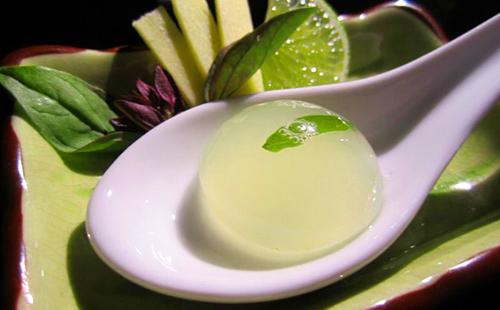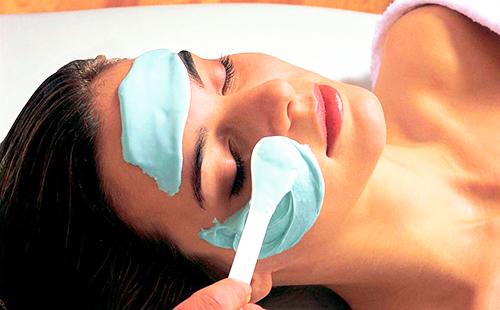The content of the article
These funds for the face received their name from the main constituent component - alginate. After the usual coffee and honey procedures, this name seems strange and even frightening, chemical. Nevertheless, it is a natural cosmetic product.
By the way, precisely because of the specific name, it is often confused with consonant aldehyde face masks. However, the latter are of a completely different nature. This is just “synthetics”, which is produced in special laboratories and cannot be repeated at home.
In the modern beauty industry, alginate-based mixtures have been used not so long ago, but cosmetologists praise them, creating a miraculous image. Is this so, and what is an alginate face mask - let's understand.

Why alginate is so appreciated
Alginate was obtained in the second half of the 20th century by an English scientist as an unexpected component in the isolation of iodine from algae. Having studied the properties of the new substance, the biochemist Moore Stanford realized that he had made a promising discovery: salts of alginic acid have a rejuvenating effect in contact with the epidermis. So sodium alginate began to be extracted from brown and red algae on an industrial scale. Facial masks, in which the action of the alginate component is enhanced by the substance diatomite, have become the best-selling product.
- Alginate. Sodium alginate or E401 is a polysaccharide, a salt product of alginate acid. It looks like a powder of the color of baked milk. The substance absorbs moisture well and, reacting with water, turns into a gel-like mixture. Alginate is widely used in the food and pharmaceutical industries as a thickener. For example, it is used as a component of capsules for medicinal powders, as well as in the production of sauces, baby food, processed cheeses. In medicine, it is recommended as a sorbent: it is believed that the substance copes well with the elimination of toxins and lowers cholesterol. Alginate-based drugs also promote wound healing.
- Diatomite. We often encounter this substance when applying scrubs. By their nature, they are petrified algae. Millions of years they lived in sea water and over time they formed a specific breed, the crumbs of which are effective and safe when removing dead cells. Diatomite is part of anti-acne drugs.

Alginate and other components: different masks from different problems
Alginate facial mask - a wide spectrum of action. Manufacturers can add other beneficial substances to the two basic components. So, you can choose a mixture depending on the condition of the skin and the problems you want to solve.
- Lifting and moisturizing. This is a traditional mask in which there are no additional components. Alginate and diatomite well tighten and saturate the skin with moisture without the help of other substances.
- Rejuvenation. In this case, collagen is added to the two basic components, which increases the firmness and elasticity of the skin, eliminates wrinkles.
- Plentiful hydration. A necessary procedure for girls with dry and flaky skin. To solve this problem, chitosan is added to the alginate mask - a substance obtained from the shells of arthropods. Chitosan forms a protective layer on the skin and thereby prevents moisture loss. Interestingly, the coating itself is able to absorb additional moisture from the environment and give it to the upper layers of the epidermis.
- Lightening and stain removal. An alginate mask with vitamin C is suitable here. In addition to a good skin color, after such a procedure, a decrease in the depth of wrinkles can be expected.
- Nutrition and cleaning. For this, alginate masks with plant components are used. For example, with chamomile, scarlet, ginger. This procedure is good for “tired” skin, when for some reason you launched a facial treatment.

Beautician himself: how to make an alginate mask at home
Alginate masks can be ordered and bought in the salon or made independently. For women who do not want to overpay, the home option is more suitable.
Caution - freezes quickly!
The pharmacy may offer you a gel or powder. In the first case, the drug is immediately applied to the face, and in the second, you need to dilute the contents of the sachet with mineral water or special serum. The price here directly depends on the manufacturer, and products of German, Japanese, French and Russian companies can advise you.
But not so simple. A distinctive feature of alginate masks is that they instantly thicken. After opening the tube or preparing the mixture, you will have three to five minutes to use the drug. Then it freezes and will no longer be used.

Rules for applying the finished mixture
If you make alginate face masks without a professional master, then you should get acquainted with the reviews of experienced. Some rules for using such mixtures differ from traditional instructions. This is what alginate caregivers recommend.
- Preparatory stage. It is important to cleanse the skin of cosmetics well, wash. Eyebrows and eyelashes should be treated with baby cream. If you want to enhance the result, apply face serum with a high concentration of active substances. Such care products usually contain plant extracts, vitamins, and minerals. The aldehyde mask enhances their effect several times and promotes deep penetration into the pores.
- Quick application. Since the mask needs to be applied promptly, and you must lie down at the same time, it is better to involve someone else in the procedure. Quickly and evenly distribute the mixture on the skin with a cosmetic spatula. Movement - from bottom to top. Here's a recommendation: make the edges of the mask denser than the coating in the main application area. So it will be easier to shoot it.Also, do not dilute the mixture too liquid, otherwise there will be streaks: the mask should resemble melted butter in density.
- Do not rinse - remove. Many people ask: - Do I need to wash my face after a mask? About five minutes, the mixture will solidify to a “rubber” consistency. After the mask must be kept for another 30 minutes. You will feel a characteristic tightening of the skin - it should be so. Then the resulting shell must be removed: carefully, not in shreds. To do this, they lower the lower edge of the mask and pull it from the chin to the hair.
Recipe
If in your locality such care products are not sold, then you can ask the pharmacist for individual components and make a mask yourself. Here, of course, you need to tinker. The preparation of the mask will take time, since the components are pre-soaked, and the prepared mixture should not be stored and reused. Moreover, the girls who made alginate masks themselves say that a more or less normal result was achieved only on the third attempt ...
Required Components
According to the simplest, classic recipe, you will need:
- alginate - one teaspoon;
- diatomite or its analogues: pearl powder, cosmetic clay in the amount of three teaspoons;
- calcium chloride or calcium sulfate for plasticization, solidification and elasticity of the composition - one ampoule;
- purified water - the amount is determined "by eye" depending on the consistency of the mixture.
Cooking steps
From the inventory you will need two bowls, a spatula or spoon, a spray bottle. So what and how to do?
- Pour alginate into a bowl with warm water so that the liquid slightly covers the powder. Stir. Leave to react for four to five hours. It is possible from morning to evening. The substance should turn into a gel, so stir the mixture periodically and add water if necessary.
- When the alginate is swollen to the desired consistency, in the second bowl we mix diatomite or its substitute and water. The mixture should look like thick sour cream.
- Mix the contents of two bowls.
- Next is calcium sulfate. There are two options. Some girls add it to the mask and quickly apply it on the face. But according to another version, the plasticizer leads to lightning-fast solidification of the mixture, and all previous manipulations go down the drain. Therefore, it is better to first distribute the mask, and spray the substance from above using a spray gun.
- After half an hour, remove the frozen shell.
I must admit that an alginate face mask at home is a troublesome business. In addition, there is always a risk of a mistake in dosage, and who knows how your skin will react to this ... Also always remember the safety rules: alginate masks can not be used if the face has signs of inflammatory processes, scratches, wounds. In addition, the procedure is contraindicated in oncological diagnoses.

